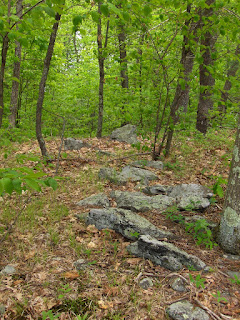by theseventhgenerationI got out for a very quick hike this morning. The spot I went to started out, well, disappointing, considering I've been finding a lot of row piles with wood in them lately. Right as I got to the East/West edge of a hay field, a line of row piles lead away from the field in a North/South line. I didn't see any wood, at least, but they were close enough together to raise my suspicion that they were 'fence rail holders'. Here is the nicest pile in the row. It has a square rock visible in this photo and that rock has a red tinge to it.

That row continued downhill until it came to a swamp, whereupon it changed from row piles to a stone wall. At that point, I went in the opposite direction, back to the hay field. Walking to the corner of the hay field and then continuing uphill in a North/South direction, there were more row piles, arguably field clearing. But I was still suspicious because sometimes they took the appearance of a stone wall and other times more like round stacked stone piles. And in another case, as in this photo, unusually large rocks grouped together and not quite in the row. You would think, if this is field clearing, the larger rocks would be closer to the edge of the field and not set back, as these were. Two of these also have a Manitou shape to them:

Across the trail were some near grade level boulders in one spot. One of those boulders was a rock on rock:

And the view from up there, by the way, was stunning. Just past the top corner of the hayfield, now getting close to 2000 feet in altitude, I continued on past where I could see any sign of obvious rock piles in a row, and then I saw a nice pile in the woods.

There were two at this site that were large, well stacked, and not in a row. They also appeared to be 'piles on piles' with something like a larger base pile all around that didn't have obvious stacking, and then these nice piles stacked on top of that base. If you click on this photo, you might be able to make out that nice triangular rock at the top of the pile. The pile also had somewhat of a depression in it.

This next photo tries to capture a portion of the site. There
were smaller row piles at the site that intersected the two larger piles.

But the two larger piles were not in the row. I thought there were other small piles around that almost gave the sense of a grid, but I can't say for sure this was a grid. It started to rain and hail, so I started to leave. Walking back down along the North/South row of the hay field, I was a bit more encouraged that there is something more to these row piles than field clearing or fence rail supporting, so I looked a little closer and saw this sitting nicely on top of one of the piles:

What a great ending to this hike!
 were several short stretches of wall that started on top of the ridge and went 20 yards or so downhill towards the pond. These all more or less lined up in the same direction and I suspect were deliberately aligned in one particular direction.
were several short stretches of wall that started on top of the ridge and went 20 yards or so downhill towards the pond. These all more or less lined up in the same direction and I suspect were deliberately aligned in one particular direction. Another view of the same short stretch, from below:
Another view of the same short stretch, from below: A few hundred yards away was a different short stretch:
A few hundred yards away was a different short stretch: Another view of the same, facing down towards the pond:
Another view of the same, facing down towards the pond: And yet again a bit further along the ridge, here is what looks like a more primitive/decrepit and smaller version of the same type of thing:
And yet again a bit further along the ridge, here is what looks like a more primitive/decrepit and smaller version of the same type of thing: Next to it, the only rock pile I saw in this part of the conservation land:
Next to it, the only rock pile I saw in this part of the conservation land: There were a few other traces of things on the exposed bedrock on top. Like this propped slab:
There were a few other traces of things on the exposed bedrock on top. Like this propped slab: In the end, although I thought the wildflower pictures were all that made the walk worthwhile, actually, there were quite a few remaining traces of ceremonialism.
In the end, although I thought the wildflower pictures were all that made the walk worthwhile, actually, there were quite a few remaining traces of ceremonialism.















































